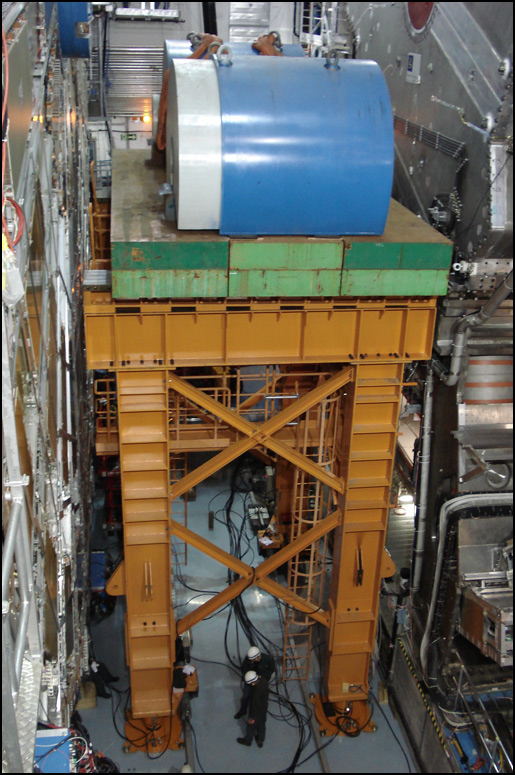
ATLAS e-News
23 February 2011
News from the pit
23 January 2008

Several large detectors were moved last December in order to prepare for the lowering of the Small Wheels which are the last detectors still to be installed, and then to prepare for closing the whole experiment.
To perform these operations, it was necessary to bring into service the last two HF (Forward Rail System) trucks. Prior to any use, a load test was done to certify the structure resistance. 450 tons of material were brought into the experimental cavern on each of these two structures for these tests. The loaded trucks were equipped with air pads and moved in order to test both the resistance and the movement system.
After having successfully performed these tests, we were ready to move the real subsystems. The End Cap Toroid was the first one to be moved parallel to the beam axis on approximately 5 meters, until it was entirely on the truck. The movement was again carried out on air pads, which made it possible to move the 360 ton End Cap Toroid with a traction force of less than 8 tons.
The End Cap calorimeter was then moved to allow a better access to the detector. There again, it was carried out on the air pads system, moving the 1000 tons of the calorimeter by applying a force of only 23 tons. Moving the End Cap calorimeter is a crucial step since the elements of the beam pipe, located in its centre, are already connected to the beam axis. Therefore, the inflation of the air pads must be controlled perfectly to avoid any damage. This is obtained from a hydraulic compensation of the inflation allowing to move at constant height with a precision of ± 1mm. The calorimeter, with its cryostat filled with liquid Argon, is connected permanently to four flexible lines whose motion is controlled by the motion of the calorimeter.
On December 20th, the truck, with the End Cap Toroid on top of it, was moved laterally by ten meters, thus opening space under the shaft for the descent of the Small Wheel. It was the first time that the HF truck moved while loaded with the toroid, and it all proceeded perfectly. A small feat, considering it has a load of more than 400 tons with its centre of gravity 12 meters above ground.
The whole of these operations will now be repeated at the other side of the experiment, under the PX16 shaft.

Michel Raymond
CERN